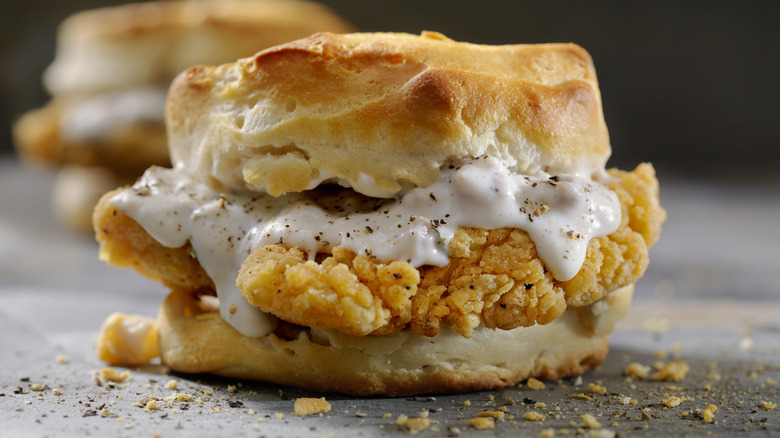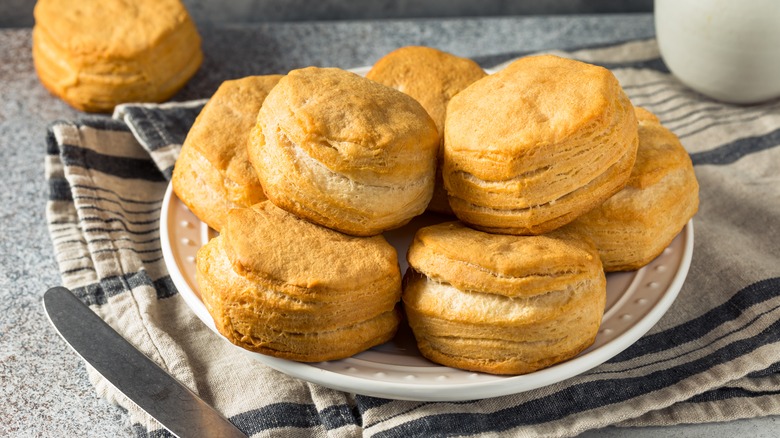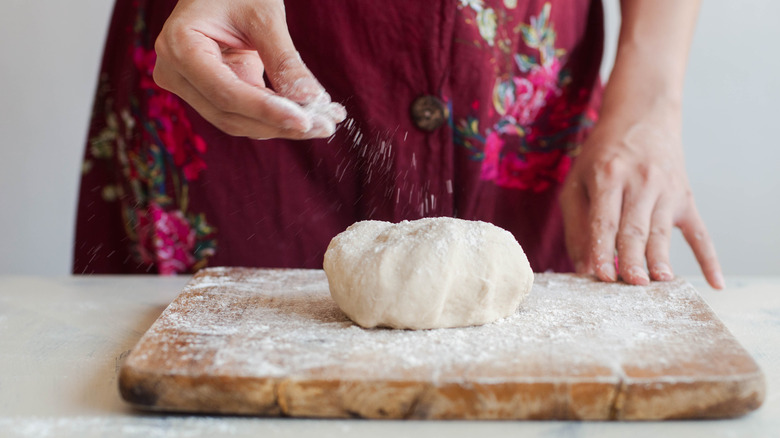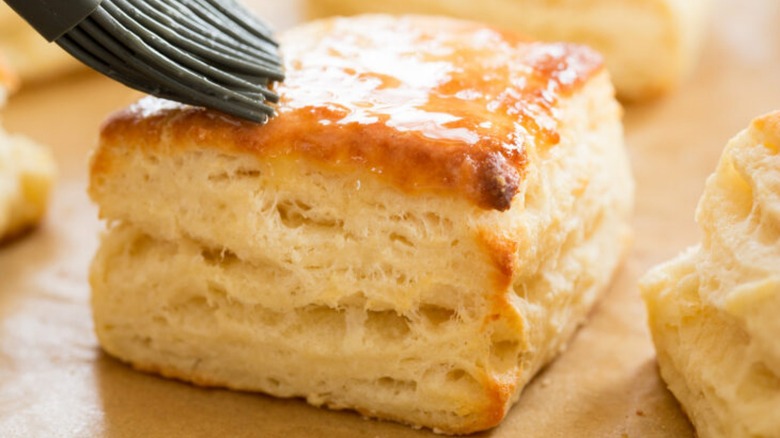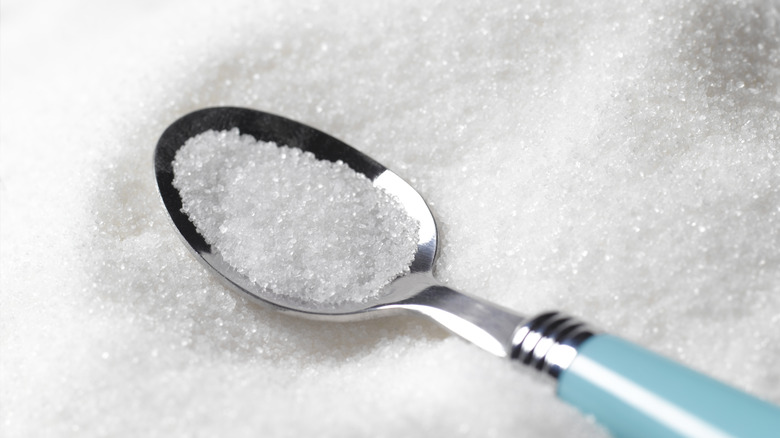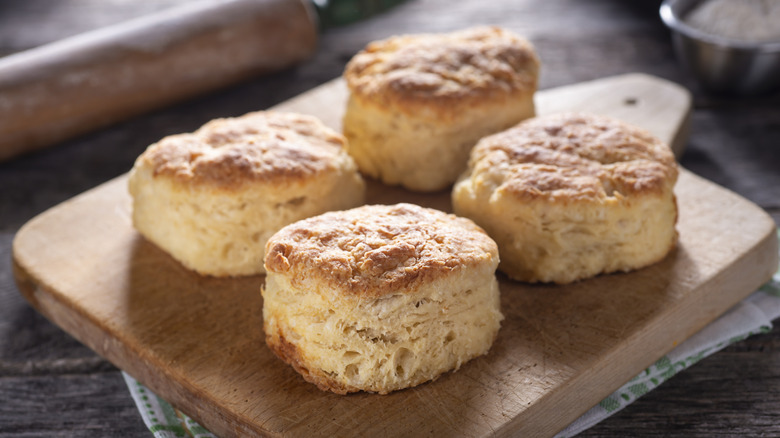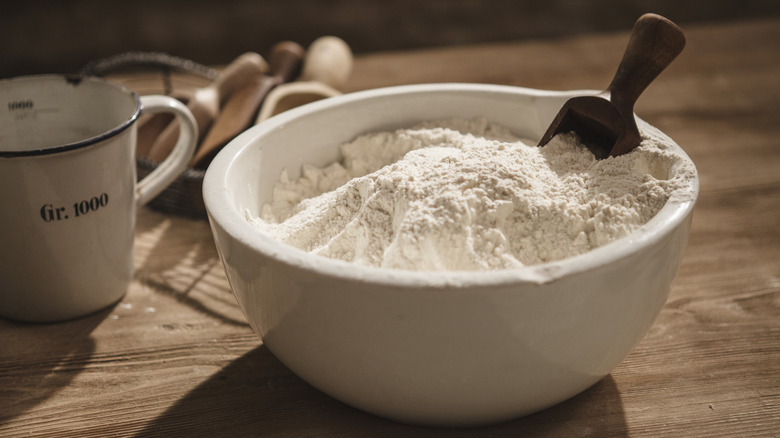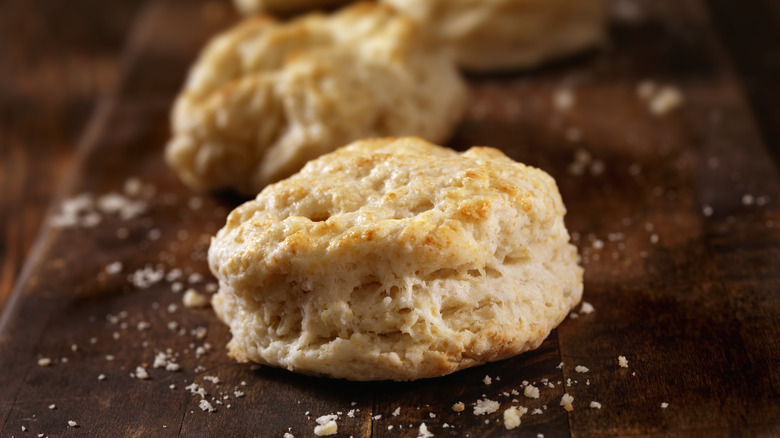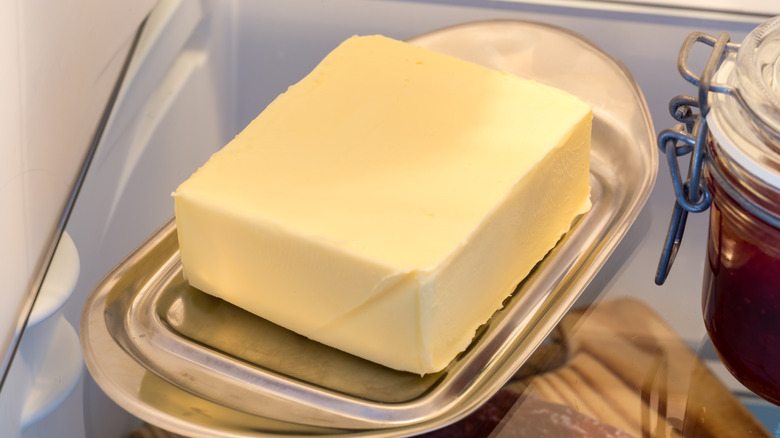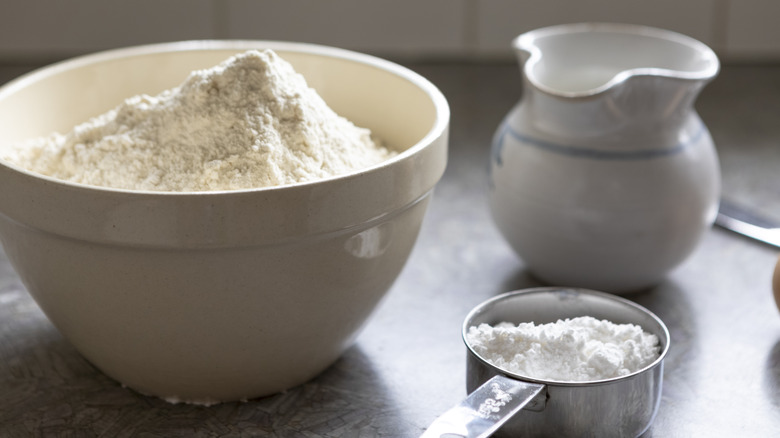Why Restaurant Biscuits Always Taste Better Than What You Make At Home
Biscuits are proof that the simplest things in life are the best. Flaky, buttery, and perfectly paired with sweet and savory foods, biscuits are an essential side to countless breakfast dishes. However, while they're pretty easy to prepare at home, common mistakes that can be made when baking biscuits suggest that they could be slightly more complicated than you think to get right — and when restaurants make them so darn well, it's no wonder that most of us prefer to order our biscuits rather than try to create them at home.
How do they do it, though? Why are restaurant biscuits so perfect, and ours so bland, boring, and hard? It's probably no surprise that restaurant chefs have countless tricks in their back pocket (and bespoke knowledge about how exactly to work their dough and what ingredients to use) that allow them to make their biscuits so delicious. The good news is that they were willing to share these tricks with us. We spoke with Hannah McClain, the Director of Culinary Training & Operations at Kentucky-based eatery Biscuit Belly, which specializes in biscuit sandwiches as well as biscuits and gravy. She broke down everything you need to know about how to make your biscuits the best.
Restaurants often rest their biscuit dough
Whether to let your dough rest or not is one of the biggest questions for any baked item. Interestingly, with biscuits it isn't a standard part of the process, and many home chefs just put their biscuits straight in the oven after forming them. However, at Biscuit Belly, employees do things differently. "We make our biscuits fresh every day, and while it isn't necessary for the dough to rest, we like to pop our cut biscuits into the cooler for about 30 minutes," Hannah McClain says. "This helps the biscuit to maintain its layers, giving it that buttery, flaky goodness."
Resting the biscuits in a cool environment stops the dough from getting too warm and slack, which can then cause the layers to meld together. This is exacerbated by the presence of butter in the biscuit. If the dough gets too warm, the butter will melt and won't have the same aerating effect that it has when baked from chilled. It's worth remembering, though, that for some biscuit recipes, resting is an integral part of the process. Yeast biscuits need time to rest so that the yeast can fully activate and rise, creating airy pockets throughout the dough.
They don't work their dough too much
Overworking your dough can be an issue with any baked item, including biscuits. That's why restaurants are cautious not to overdo things. "It's a delicate balance between overworking and underworking your dough. There's a bit of 'Goldilocks method' to how much your dough should be handled," Hannah McClain explains. "Not enough and you risk losing your layers, and your biscuits will lack uniformity. Overworking your dough will lead to your biscuits being dense on the inside with a darker crust since the butter will have melted too much."
This density comes from the overdevelopment of gluten in the flour when you knead your dough too rigorously. This gluten toughens up the biscuit and stops it from being flaky. The butter melting, meanwhile, is a result of your warm hands coming into contact with your dough for too long, which increases its overall temperature. While some recipes designate a specific amount of times you should stir your dough to bring it together, it's best to keep things more simple. Only re-roll the dough once, and stop kneading it when your dough is a smooth, even consistency, with no pockets or lumps of flour throughout.
Some restaurants bake their biscuits at a lower temperature
You can't go wrong with your oven set at 400 degrees Fahrenheit. That seems to be the conventional wisdom for cooking anything, whether it's baked goods like biscuits or main dishes like lasagna. However, some restaurants do things a little differently than you might expect with their biscuits. Hannah McClain of Biscuit Belly explains why. "Typically bakers look to use a high temp for a short amount of time to help get the rise you need for biscuits/bread," McClain tells us. "However, we bake our biscuits at 350 degrees for a little longer since we get our rise through both folding and laminating our dough, creating those layers."
McClain acknowledges that this isn't the standard temperature that most other biscuit makers bake their biscuits at — but it has its advantages. Baking them at a lower temperature creates an almost croissant-like texture in the biscuits, giving them the fluffiness and flakiness that we all crave. Bear in mind that for this to be effective, you need to ensure that your butter remains cool and doesn't melt into the dough. Otherwise, you'll simply end up with flat, dense biscuits, which don't exactly make for good biscuits and gravy.
Their biscuits are made by hand
It's easy to assume that restaurant biscuits are subject to a more intense production process, like those that might be mass-produced, packaged, and shipped to your local store. Nope. Most restaurant biscuits are actually made entirely by hand in the restaurant. This is even true of chain restaurants like Hardees, where biscuit makers start their shifts as early as 4 a.m. and can churn out up to 500 biscuits during an average work day.
Making biscuits by hand, instead of throwing the ingredients in a machine, gives restaurant biscuits a certain rustic edge. It also means that biscuit makers are better equipped to tweak their recipes and quantities on the fly, depending on what their dough needs or what the heat or humidity of their kitchen is like on any given day. It's this attention to detail, combined with years of skill and experience, that makes restaurant biscuits taste so much better. The good news, though, is that you're likely making your biscuits by hand too (unless you've set up a mini-biscuit factory in your kitchen) — you just need to get in some more practice.
Butter is brushed on after baking, not before
In our opinion, you can't make biscuits without butter (well, you can, but unless you're vegan or need to avoid butter for dietary purposes, we wouldn't recommend it — it just won't taste as good). When you add your butter, though, can make a huge difference. Naturally, you'll need to add the main bulk of your butter to your dough, kneading it into the flour while it's still cold. Melting the rest of your butter and brushing it on top of your baked biscuits can give them an extra kick of flavor, but adding it beforehand is a big no-no.
"I would recommend topping them with butter after baking if you want that extra bit of butter flavor on top," Hannah McClain says. "If you butter before you bake, you risk burning the butter." This is a mistake that all too many home chefs make, to their biscuits' detriment. Butter's high concentration of milk solids makes it especially prone to burning, and while this is more likely to happen when it's exposed to contact heat (like in a pan), it can still happen in the oven — it's why butter isn't quite the egg wash substitute you think it is. Protect your biscuits, and dab them with butter once they're almost on the table.
Restaurants often add in a secret ingredient - sugar
Southern-style biscuits generally don't have sugar in their recipes. This is partly what makes them so versatile. Their relatively plain flavor means that they don't bring too much sweetness to savory dishes, and they don't make your sweet dishes too sugary. However, one thing that restaurants aren't telling you is that they often sneak a little sugar into the mix. They don't go wild here, though. If they're using sugar (and not all restaurants do, of course), chefs will generally add about 3 tablespoons of sugar per 4 cups of flour.
This sugar adds an undertone of gentle sweetness that usually isn't super noticeable, but it helps to amplify and counterbalance anything savory you're serving with them. It's kind of the same principle as adding a pinch of sugar into a pasta sauce or gravy. The top note will still be savory, but the sweetness acts as a flavor enhancer. Adding sugar to biscuits also helps them develop a slightly deeper brown color, thanks to it caramelizing gently as it cooks. If you're adding sugar, though, make sure it's mixed thoroughly into your dry ingredients before you start kneading in your butter. You don't want clumps of sugar ruining your dough.
They're not afraid to add heavy cream
Buttermilk biscuits are normally made with — you guessed it! — buttermilk, and we can understand why. Buttermilk doesn't just give biscuits a dairy-rich, smooth flavor and an important fat content. It also provides an acidity that helps the biscuits rise by reacting with the baking soda in your recipe, giving you a bigger and more satisfying result.
However, one thing restaurants aren't telling you is that they often sub out buttermilk for heavy cream. Using heavy cream instead of buttermilk gives the biscuits a way higher fat content and therefore a richer, creamier flavor. What heavy cream doesn't have is the acidity that helps biscuits rise, but as long as you're using baking powder or self-rising flour, you should still be able to harness some leavening power.
It's worth pointing out, though, that as long as you're using heavy cream or buttermilk, your biscuits should still be delicious. "You can use one or the other or both. They make for the best flavor and mouthfeel for biscuits," says Hannah McClain. At the end of the day, it comes down to personal preference.
Restaurants are strict about their measurements
Here's the paradox about biscuits: They look like they're rustic and thrown together, but the process that goes into making them is often pretty specific. One thing restaurants never do is get their measurements wrong. "There's a certain level of error you must avoid when baking at home," Hannah McClain says. "It's truly a science and a little bit 'too much' or 'not enough' of something can cause your biscuits to come out flat, overbaked, doughy, and so on."
That's why restaurants measure out their ingredients strictly before they even start putting their biscuits together. They often do this by creating a dry mix, consisting of their flour, baking soda, and salt, which stops things from going wrong. "While they are still scratch-made and there is room for error if our process isn't followed or our liquid goods are off, it does help eliminate a lot of the measuring that could lead to mistaking a teaspoon for a tablespoon and making some salty biscuits," McClain says. You don't just have to stop at your dry ingredients, though: Make sure your liquids and butter are carefully portioned out before you start to make your dough, so that you don't make any mistakes or discover that you don't have enough of something halfway through.
At the end of the day, practice makes perfect
One of the biggest reasons why restaurant biscuits taste better than the ones you make at home is, to be totally honest with you, frustratingly simple. It's because restaurant chefs do it every single day. "I don't think there are necessarily special methods or techniques that we use or make our biscuits better, but I do believe that restaurants hire and train these skills, so you have someone who works with dough each and every day at work," Hannah McClain says about the biscuits at Biscuit Belly. "So, the special 'technique' that sets restaurants apart is truly experience and having the knowledge of biscuits."
We can understand how this might seem annoying to some folks — after all, we just want that secret recipe to make all the difference, right? But the good news is that anyone can get to that level. You simply have to put in the time and the work. If you dedicate yourself to making multiple batches of biscuits, you'll soon be able to tell the difference between the ones that worked and the ones that didn't and adjust your technique, recipe, and ingredients accordingly. Pretty soon, yours will be restaurant-quality too.
When restaurants cut their biscuits, they never twist
Cutting your biscuit dough is a little more complicated than you think — and there's a key mistake that almost all home cooks make that inadvertently ruins them. When restaurant chefs cut their dough with a cutter, they know that they shouldn't twist the wrist, which folks often do to try and get a cleaner cut. If you twist your cutter once it's pressed down, you smooth the dough on the sides around the biscuit, and close it off. This then prevents it from rising up and creating those fluffy layers as it bakes, and instead you end up with a hockey puck of a biscuit that's hard and compact.
For the best biscuits, cut the dough by pressing down with your cutter in one smooth, vertical motion. Once your biscuit has been cut into shape, simply pull it out and place it to the side. Don't worry about your dough sticking. If it's the right consistency and your butter was cold enough, it should remain solid and robust, and you shouldn't have any trouble pulling it away. If your dough is sticky and you can't cut it with a single motion, it could be a sign that you need to add more flour.
Restaurants make sure their ingredients are super-cold
When restaurants make their biscuits, they know that they need to keep things chilled. Seriously chilled. At Biscuit Belly, employees make sure their ingredients are as cold as possible before beginning. "Your liquids, aka buttermilk and/or heavy cream and your butter, need to be at 41 degrees or below," explains Hannah McClain. It's not just your liquids that need to be cold, either. "There are bakers who prefer to freeze their butter, and don't get me wrong, it needs to be cold, but that doesn't necessarily mean it has to be frozen. As long as it's 41 degrees or below, you're in good shape."
Why is it so important that your ingredients are as cold as possible? The idea is to ensure that your butter remains as cool as possible. If your butter warms up too much, it simply melts into your flour, and this stops your biscuits from being able to rise properly. Keeping your other ingredients cool helps to insulate your butter. It's worth remembering that temperatures can rise quicker than you think, especially in hot climates and kitchens, so only pull your ingredients out of the fridge just before you're ready to make your dough.
Quality ingredients are vital for a good biscuit
When you're making any food, it'll only really ever turn out as good as the ingredients you use. This is especially true when you're making simple items like biscuits. In baked goods like these, every ingredient counts. You don't have loads of herbs and spices to boost flavor or loads of salt to amplify things. So you have to make sure that every individual item is the best it can be.
It's something employees swear by at Biscuit Belly when making their dry mix. "As a restaurant, we have access to quality ingredients and are able to make a proprietary mix, which keeps our dry mix consistent with each batch we make," says Hannah McClain. Knowing that each mix is made with quality ingredients ensures that each biscuit is as good as the last. It's worth considering what type of each ingredient you use, too. For instance, opting for a combination of cake flour and all-purpose flour can give you a balance of fluffiness and bite that you wouldn't get by just using one or the other.
